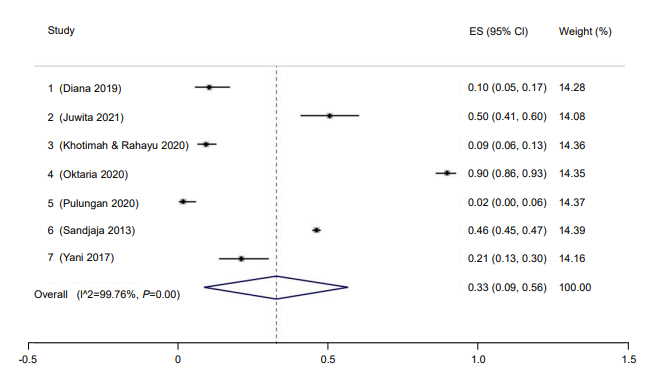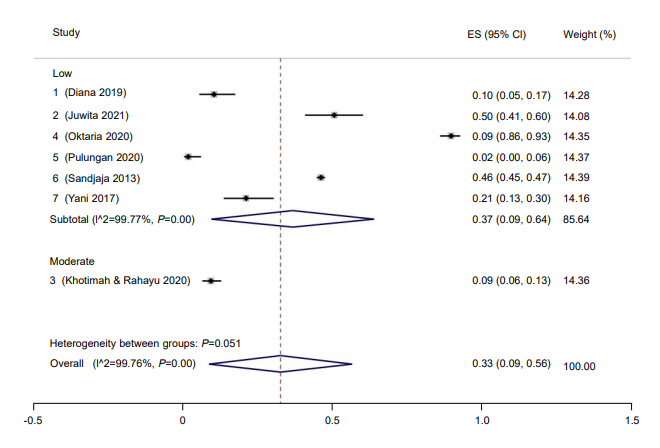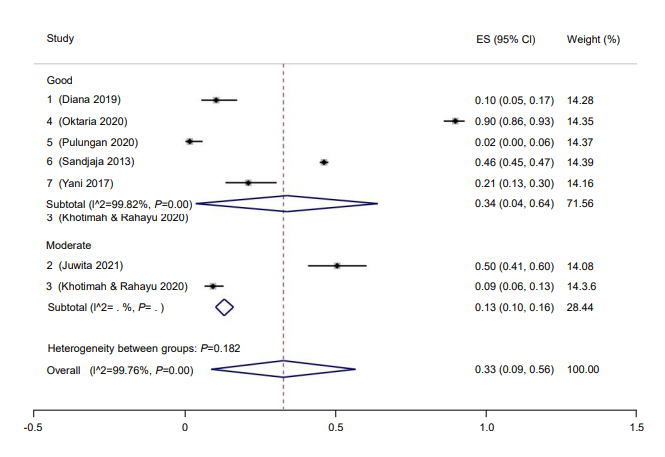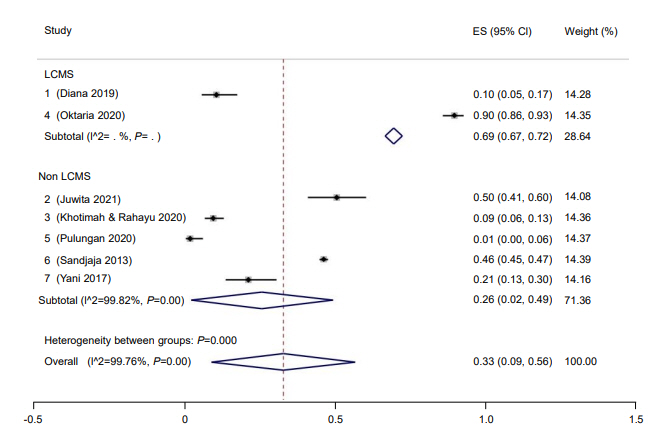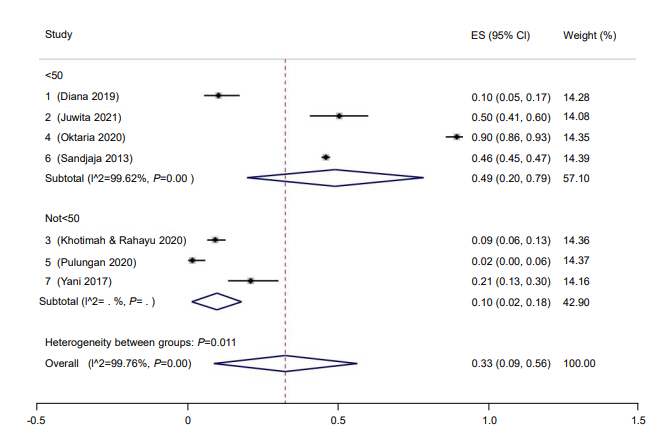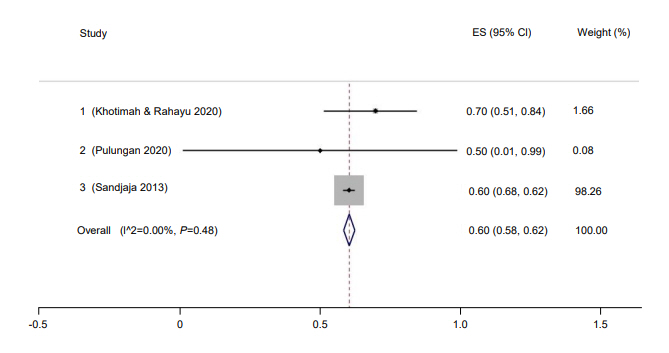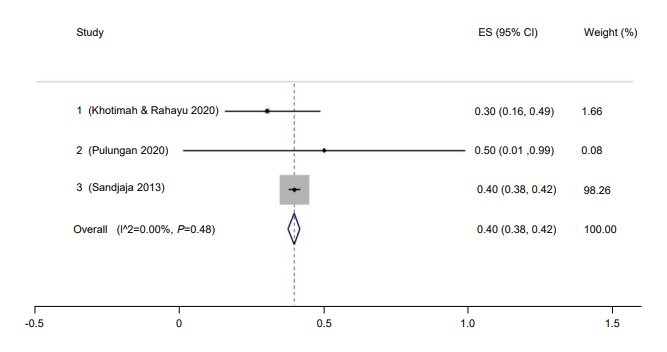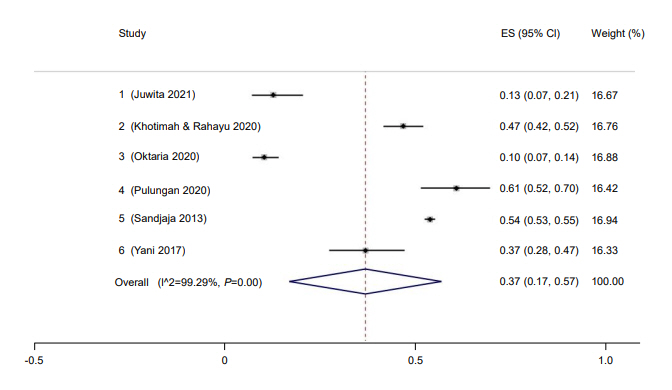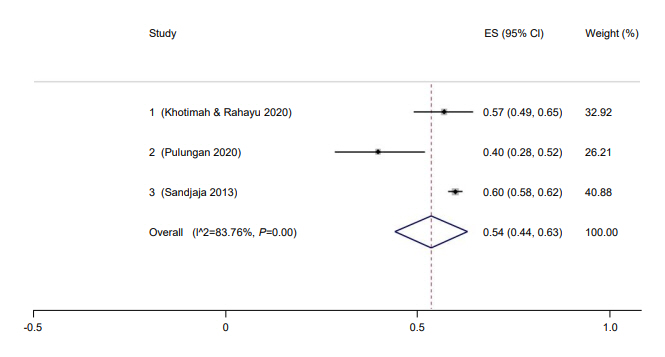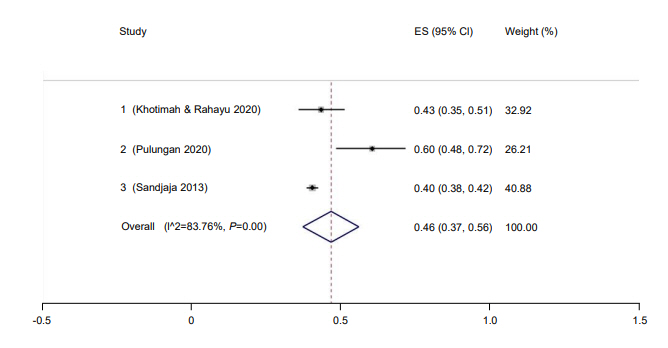Ann Pediatr Endocrinol Metab.
2023 Mar;28(1):10-19. 10.6065/apem.2244170.085.
Vitamin D deficiency is a public health emergency among Indonesian children and adolescents: a systematic review and meta-analysis of prevalence
- Affiliations
-
- 1Department of Pediatrics, Universitas Pelita Harapan, Jakarta, Indonesia
- KMID: 2540782
- DOI: http://doi.org/10.6065/apem.2244170.085
Abstract
- Purpose
This study aimed to describe the prevalence of vitamin D deficiency in Indonesian children and adolescents.
Methods
This was a meta-analysis of prevalence using the Hartung-Knapp-Sidik-Jonkman method with a random effects model. A prediction interval was used to estimate true effects. We searched PubMed, MEDLINE, Cochrane Library, Science Direct, Google Scholar, and 3 Indonesian databases (Indonesian Scientific Journal Database, Neliti, and Indonesia One Search). We included cross-sectional or case-control studies that provided data on the prevalence of vitamin D deficiency. We excluded case reports, case series, cohort studies, or studies outside Indonesia. We computed point prevalence by dividing the number of children with hypovitaminosis D by the total number of subjects in that study. This review was registered with PROSPERO (International Prospective Register of Systematic Reviews) (CRD42022329814).
Results
Of 1,397 manuscripts identified, 7 were included in this review. A total of 5,870 children were included in this meta-analysis, ranging in age from 6 months to 19 years. The prevalence of hypovitaminosis D in Indonesia was calculated as 33% (95% confidence interval [CI], 9–56) and was higher in females (60% [95% CI, 58–62]) than in males (40% [95% CI, 38–42]). Mean serum vitamin D level was 22.74 ng/mL (95% CI, 16.95–30.51) with a prediction interval of 15.96 ng/mL to 29.52 ng/mL.
Conclusion
Vitamin D deficiency is a public health emergency in Indonesia. Strategies to detect and treat vitamin D deficiency in Indonesian children and adolescents should be implemented immediately.
Figure
Reference
-
References
1. Darnton-Hill I. Public health aspects in the prevention and control of Vitamin deficiencies. Curr Dev Nutr. 2019; 3:nzz075.2. Bouillon R, Marcocci C, Carmeliet G, Bikle D, White JH, Dawson-Hughes B, et al. Skeletal and extraskeletal actions of vitamin D: current evidence and outstanding questions. Endocr Rev. 2019; 40:1109–51.3. Roth DE, Abrams SA, Aloia J, Bergeron G, Bourassa MW, Brown KH, et al. Global prevalence and disease burden of vitamin D deficiency: a roadmap for action in low- and middle-income countries. Ann N Y Acad Sci. 2018; 1430:44–79.4. Scragg R, Sluyter JD. Is there proof of extraskeletal benefits from vitamin D supplementation from recent mega trials of vitamin D? JBMR Plus. 2021; 5:e10459.5. Siadat ZD, Kiani K, Sadeghi M, Shariat AS, Farajzadegan Z, Kheirmand M. Association of vitamin D deficiency and coronary artery disease with cardiovascular risk factors. J Res Med Sci. 2012; 17:1052–5.6. Tomaszewska A, Rustecka A, Lipińska-Opałka A, Piprek RP, Kloc M, Kalicki B, et al. The role of vitamin D in COVID-19 and the impact of pandemic restrictions on vitamin D blood content. Front Pharmacol. 2022; 13:836738.7. Dror AA, Morozov N, Daoud A, Namir Y, Yakir O, Shachar Y, et al. Pre-infection 25-hydroxyvitamin D3 levels and association with severity of COVID-19 illness. PLoS One. 2022; 17:e0263069.8. Cashman KD. Vitamin D deficiency: a public health issue in high- and low-income countries or just hype? World Rev Nutr Diet. 2017; 118:206–14.9. Cashman KD, Dowling KG, Škrabáková Z, Gonzalez-Gross M, Valtueña J, De Henauw S, et al. Vitamin D deficiency in Europe: pandemic? Am J Clin Nutr. 2016; 103:1033–44.10. Cashman KD. Global differences in vitamin D status and dietary intake: a review of the data. Endocr Connect. 2022; 11:e210282.11. Khandelwal S, Kurpad A. A vision for nutrition research in Asia. Food Nutr Bull. 2019; 40:133–42.12. Weydert JA. Vitamin D in children's health. Children (Basel). 2014; 1:208–26.13. Mithal A, Kalra S. Vitamin D supplementation in pregnancy. Indian J Endocrinol Metab. 2014; 18:593–6.14. Haimi M, Kremer R. Vitamin D deficiency/insufficiency from childhood to adulthood: Insights from a sunny country. World J Clin Pediatr. 2017; 6:1–9.15. Sandjaja S, Budiman B, Harahap H, Ernawati F, Soekatri M, Widodo Y, et al. Food consumption and nutritional and biochemical status of 0·5-12-year-old Indonesian children: the SEANUTS study. Br J Nutr. 2013; 110 Suppl 3:S11–20.16. Siddiqee MH, Bhattacharjee B, Siddiqi UR, Rahman MM. High burden of hypovitaminosis D among the children and adolescents in South Asia: a systematic review and meta-analysis. J Health Popul Nutr. 2022; 41:10.17. Cashman KD, Sheehy T, O'Neill CM. Is vitamin D deficiency a public health concern for low middle income countries? A systematic literature review. Eur J Nutr. 2019; 58:433–53.18. Martin EG, Begany GM. Opening government health data to the public: benefits, challenges, and lessons learned from early innovators. J Am Med Inform Assoc. 2017; 24:345–51.19. Page MJ, McKenzie JE, Bossuyt PM, Boutron I, Hoffmann TC, Mulrow CD, et al. The PRISMA 2020 statement: an updated guideline for reporting systematic reviews. BMJ. 2021; 372:n71.20. Yati NP, Batubara JRL, Suryawan IWB. Vitamin D: Panduan praktis klinis Ikatan Dokter Anak Indonesia. Jakarta: Badan Penerbit Ikatan Dokter Anak Indonesia;2018.21. Judistiani RTD, Madjid TH, Irianti S, Natalia YA, Indrati AR, Ghozali M, et al. Association of first trimester maternal vitamin D, ferritin and hemoglobin level with third trimester fetal biometry: result from cohort study on vitamin D status and its impact during pregnancy and childhood in Indonesia. BMC Pregnancy Childbirth. 2019; 19:112.22. Britto C, Pollard AJ, Voysey M, Blohmke CJ. An appraisal of the clinical features of pediatric enteric fever: systematic review and meta-analysis of the age-stratified disease occurrence. Clin Infect Dis. 2017; 64:1604–11.23. Ouzzani M, Hammady H, Fedorowicz Z, Elmagarmid A. Rayyan-a web and mobile app for systematic reviews. Syst Rev. 2016; 5:210.24. Wells G, Shea B, O'Connell D, Peterson J, Losos M, et al. The Newcastle-Ottawa Scale (NOS) for assessing the quality of nonrandomised studies in meta-analyses [Internet]. Ottawa (ON): Ottawa Hospital Research Institute;2014. [cited 2022 Jun 20]. Available from: http://www.ohri.ca/programs/clinical_epidemiology/oxford.asp.25. The Joanna Briggs Institute. Checklist for prevalence studies [Internet]. Adelaide (Australia): The Joanna Briggs Institute;2017. [cited 2022 Jun 20]. Available from: https://jbi.global/sites/default/files/2019-05/JBI_Critical_Appraisal-Checklist_for_Prevalence_Studies2017_0.pdf.26. Noordzij M, Dekker FW, Zoccali C, Jager KJ. Measures of disease frequency: prevalence and incidence. Nephron Clin Pract. 2010; 115:c17–20.27. Borenstein M. Research Note: In a meta-analysis, the I2 index does not tell us how much the effect size varies across studies. J Physiother. 2020; 66:135–9.28. Gao J, Yang L, Zhao J, Wang L, Zou J, Wang C, et al. Comparison of problem-based learning and traditional teaching methods in medical psychology education in China: a systematic review and meta-analysis. PLoS One. 2020; 15:e0243897.29. Page M, Higgins J, Sterne J. Chapter 13: Assessing risk of bias due to missing results in a synthesis. In : Higgins JPT, Thomas J, Chandler J, Cumpston M, Li T, Page MJ, editors. Cochrane handbook for systematic reviews of interventions. 2nd ed. Chichester (UK): John Wiley & Sons;2019. p. 349–74.30. Begg CB, Mazumdar M. Operating characteristics of a rank correlation test for publication bias. Biometrics. 1994; 50:1088–101.31. Egger M, Davey Smith G, Schneider M, Minder C. Bias in meta-analysis detected by a simple, graphical test. BMJ. 1997; 315:629–34.32. Duval S, Tweedie R. Trim and fill: a simple funnel-plot-based method of testing and adjusting for publication bias in meta-analysis. Biometrics. 2000; 56:455–63.33. Nyaga VN, Arbyn M, Aerts M. Metaprop: a Stata command to perform meta-analysis of binomial data. Arch Public Health. 2014; 72:39.34. Juliaty A, Daud D, Lisal JS. Correlation between vitamin D deficiency and fasting blood glucose levels in obese children. Clin Nutr ESPEN. 2021; 44:200–3.35. Tromp IIM, Franco OH, van den Hooven EH, Heijboer AC, Jaddoe VWV, Duijts L, et al. 25-Hydroxyvitamin D concentrations, asthma and eczema in childhood: The generation R study. Clin Nutr. 2018; 37:169–76.36. Oktaria V, Danchin M, Triasih R, Soenarto Y, Bines JE, Ponsonby AL, et al. The incidence of acute respiratory infection in Indonesian infants and association with vitamin D deficiency. PLoS One. 2021; 16:e0248722.37. Oktaria V, Triasih R, Graham SM, Bines JE, Soenarto Y, Clarke MW, et al. Vitamin D deficiency and severity of pne umoni a in Indonesi an chi ldren. PLoS One. 2021; 16:e0254488.38. Oktaria V, Graham SM, Triasih R, Soenarto Y, Bines JE, Ponsonby AL, et al. The prevalence and determinants of vitamin D deficiency in Indonesian infants at birth and six months of age. PLoS One. 2020; 15:e0239603.39. Soesanti F, Pulungan A, Tridjaja B, Batubara JRL. Vitamin D profile in healthy children aged 7-12 years old in Indonesia. Int J Pediatr Endocrinol. 2013; 2013(Suppl 1):P167.40. Pulungan A, Soesanti F, Tridjaja B, Batubara J. Vitamin D insufficiency and its contributing factors in primary school-aged children in Indonesia, a sun-rich country. Ann Pediatr Endocrinol Metab. 2021; 26:92–8.41. Valentina V, Palupi NS, Andarwulan N. Asupan kalsium dan vitamin D pada anak indonesia usia 2-12 tahun. J Teknol Ind Pangan. 2014; 25:83–9.42. Ernawati F, Budiman B. Status vitamin D terkini anak Indonesia usia 2,0-12,9 Tahun. Gizi Indonesia. 2015; 38:73–80.43. Ernawati F, Syauqy A, Arifin AY, Soekatri MYE, Sandjaja S. Micronutrient deficiencies and stunting were associated with socioeconomic status in indonesian children aged 6-59 months. Nutrients. 2021; 13:1802.44. Nguyen Bao KL, Sandjaja S, Poh BK, Rojroongwasinkul N, Huu CN, Sumedi E, et al. The consumption of dairy and its association with nutritional status in the South East Asian Nutrition Surveys (SEANUTS). Nutrients. 2018; 10:759.45. Poh BK, Rojroongwasinkul N, Nguyen BK, Ruzita AT, Yamborisut U, et al. 25-hydroxy-vitamin D demography and the risk of vitamin D insufficiency in the South East Asian Nutrition Surveys (SEANUTS). Asia Pac J Clin Nutr. 2016; 25:538–48.46. Diana A, Purnamasari DM, Rahmannia S, Luftimas DE, Haszard JJ, Gibson RS, et al. Multimicronutrient biomarkers are related to anemia during infancy in indonesia: a repeated cross-sectional study. Curr Dev Nutr. 2019; 3:nzz022.47. Juwita F, Gumilang L, Risan NA, Dhamayanti M. The association of vitamin D and neurodevelopmental status among 2 years old infants. Glob Pediatr Health. 2021; 8:2333794. X211034075.48. Khotimah E, Rahayu L. Analisa kadar vitamin D 25 (OH) total pada pasien usia 10–19 tahun yang melakukan pemeriksaan di prodia kelapa Gading-Jakarta. Jurnal Bidang Ilmu Kesehatan. 2020; 10:160–8.49. Yani FF, Lipoeto NI, Supriyatno B, Darwin E, Basir D. Vitamin D status in under-five children with a history of close tuberculosis contact in Padang, West Sumatra. Asia Pac J Clin Nutr. 2017; 26(Suppl 1):S68–72.50. Badan Pusat Statistik. Jumlah penduduk menurut kelompok umur dan jenis kelamin, 2022 [Internet]. Jakarta (Indonesia): Badan Pusat Statistik;2021. [cited 2022 Jun 21]. Available from: https://www.bps.go.id/indikator/indikator/view_data_pub/0000/api_pub/YW40a21pdTU1cnJxOGt6dm43ZEdoZz09/da_03/1.51. Jeyakumar A, Shinde V. A systematic review and meta-analysis of prevalence of vitamin D deficiency among adolescent girls in selected Indian states. Nutr Health. 2019; 25:61–70.52. Mogire RM, Mutua A, Kimita W, Kamau A, Bejon P, Pettifor JM, et al. Prevalence of vitamin D deficiency in Africa: a systematic review and meta-analysis. Lancet Glob Health. 2020; 8:e134–42.53. Oktaria V, Putri DAD, Ihyauddin Z, Julia M, Sulistyoningrum DC, Koon PB, et al. Vitamin D deficiency in South-East Asian children: a systematic review. Arch Dis Child. 2022; archdischild-2021-323765.54. Torkaman M, Abolghasemi H, Amirsalari S, Beiraghdar F, Afsharpaiman S, Kavehmanesh Z, et al. Comparison of the vitamin D status of children younger and older than 2 years in Tehran: are supplements really necessary? Int J Endocrinol Metab. 2016; 14:e34676.55. Odhaib SA, Alibrahim NT, Zaboon IA, Mansour AA. Vitamin D metabolic profiles in premenopausal women we aring niqab and hijab in sunny B asrah. Cureus. 2021; 13:e14909.56. Alharbi AA, Alharbi MA, Aljafen AS, Aljuhani AM, Almarshad AI, Alomair IA, et al. Gender-specific differences in the awareness and intake of Vitamin D among adult population in Qassim Region. J Family Community Med. 2018; 25:148–54.57. Haidich AB. Meta-analysis in medical research. Hippokratia. 2010; 14(Suppl 1):29–37.58. Sempos CT, Vesper HW, Phinney KW, Thienpont LM, Coates PM; Vitamin D Standardization Program (VDSP). Vitamin D status as an international issue: national surveys and the problem of standardization. Scand J Clin Lab Invest Suppl. 2012; 243:32–40.59. Deeks JJ, Higgins JPT, Altman DG. Chapter 10: Analysing data and undertaking meta-analyses. In : Higgins JPT, Thomas J, Chandler J, Cumpston M, Li T, Page MJ, editors. Cochrane handbook for systematic reviews of interventions. 2nd ed. Chichester (UK): John Wiley & Sons;2019. p. 241–84.60. Jacobs ET, Martínez ME, Jurutka PW. Vitamin D: marker or mechanism of action? Cancer Epidemiol Biomarkers Prev. 2011; 20:585–90.61. Suaini NH, Koplin JJ, Ellis JA, Peters RL, Ponsonby AL, Dharmage SC, et al. Environmental and genetic determinants of vitamin D insufficiency in 12-month-old infants. J Steroid Biochem Mol Biol. 2014; 144 Pt B:445–54.62. Angelin TC, Bardosono S, Shinta D, Fahmida U. Growth, dietary intake, and vitamin D receptor (VDR) promoter genotype in Indonesian school-age children. Nutrients. 2021; 13:2904.63. Zhou YF, Luo BA, Qin LL. The association between vitamin D deficiency and community-acquired pneumonia: a meta-analysis of observational studies. Medicine (Baltimore). 2019; 98:e17252.64. Aji AS, Erwinda E, Rasyid R, Yusrawati Y, Malik SG, Alathari B, et al. A genetic approach to study the relationship b etween maternal Vit amin D st atus and ne w b orn anthropometry measurements: the Vitamin D pregnant mother (VDPM) cohort study. J Diabetes Metab Disord. 2020; 19:91–103.65. Dhamayanti M, Noviandhari A, Supriadi S, Judistiani RT, Setiabudiawan B. Association of maternal vitamin D deficiency and infants' neurodevelopmental status: a cohort study on vitamin D and its impact during pregnancy and childhood in Indonesia. J Paediatr Child Health. 2020; 56:16–21.66. Ariganjoye R. Pediatric Hypovitaminosis D: molecular perspectives and clinical implications. Glob Pediatr Health. 2017; 4:2333794X16685504.67. Holick MF, Binkley NC, Bischoff-Ferrari HA, Gordon CM, Hanley DA, Heaney RP, et al. Evaluation, treatment, and prevention of vitamin D deficiency: an Endocrine Society clinical practice guideline. J Clin Endocrinol Metab. 2011; 96:1911–30.68. Borenstein M, Higgins JP, Hedges LV, Rothstein HR. Basics of meta-analysis: I2 is not an absolute measure of heterogeneity. Res Synth Methods. 2017; 8:5–18.69. Hoaglin DC. Misunderstandings about Q and 'Cochran's Q test' in meta-analysis. Stat Med. 2016; 35:485–95.70. Cashman KD. Vitamin D deficiency: defining, prevalence, causes, and strategies of addressing. Calcif Tissue Int. 2020; 106:14–29.
- Full Text Links
- Actions
-
Cited
- CITED
-
- Close
- Share
- Similar articles
-
- Correlation between Vitamin B12 and Mental Health in Children and Adolescents: A Systematic Review and Meta-analysis
- Internet Addiction and Online Gaming Disorder in Children and Adolescents During COVID-19 Pandemic: A Systematic Review
- Essential micronutrients in children and adolescents with a focus on growth and development: a narrative review
- A review of vitamin D deficiency and vitamin D receptor polymorphisms in endocrine-related disorders
- The role of vitamin D deficiency on COVID-19: a systematic review and meta-analysis of observational studies

